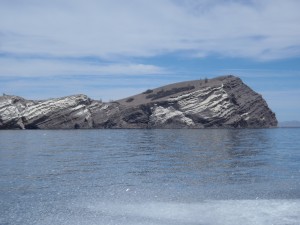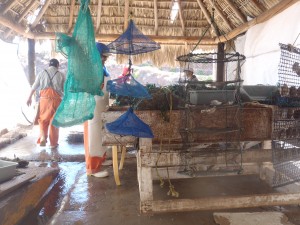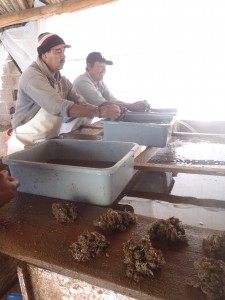After a day motoring the Gulf, we camped in the bay of a small island with steep and craggy hills, called Isla Salsipuedes, which literally translates to ‘get out if you can.’ On this small island, whose name is a warning to fishermen of dangerous winds that may flip their panga (local name for a fishing boat), we camped near Kino fishermen in a secluded harbor. These fishermen had planned to camp there at least a week, in the hope of catching enough fish to recoup the cost of gas and food. These and all other Kino fishermen work on a tight budget, and they must catch a sufficient bounty to cover expenses, and hope for a profit, before their food runs out for the week. Given the constant financial pressure, many Kino fishermen illegally harvest sea cucumbers – pepinos – because there is a high demand, in large part from the Chinese market. Due to overfishing, most of the Gulf of California is off limits for pepino harvest. Kino fishermen sell their illegal catch to dealers who credit the catch to the legally-permitted pepino fishermen, and thus skirt the regulations. These dealers then move pepinos on to feed China’s ever-hungry demand for seafood products.



The benefits of fishing pepinos is clear – steady demand means a relatively sure bet for fishermen to have a profitable day on the water – if they don’t get caught. As Cosme our boat captain explained it to me, if a fishermen is caught harvesting pepinos, they will be fined, sent to jail, and all their gear will be confiscated, including their boat. Cosme knew several fishermen who had gone to jail for 9 months or more for being caught harvesting pepinos. But with so little enforcement in the Gulf, many Kino fishermen take their chances.
The international market has also inspired and even allowed for the possibility of legal entrepreneurship, as our class witnessed at the Perlas de mar de Cortez (Sea of Cortez pearl farm) in Guaymas. The aquaculture facility owner Enrique shared his experience early on of finding good buyers, and inserting the beautiful blue pearls into the fine gem and gemstone market. Given the eco-friendly goals of the pearl farmers, the pearls can’t be sold to just anyone at a low price – it is costly to produce a high quality product at low volume. Thus reaching a global market through international gem and jewelry shows – like those in Switzerland, Hong Kong, and Tucson – allows Enrique the opportunity to reach buyers who look for unique items, and value the fair-trade and environmentally-friendly pedigree his pearl farm carries. According to Enrique, without this world market it would be hard to compete with many low-quality pearl farmers that are based in China.




Walking the rocky shore of islands like Salsipuedes, quiet in the wide gulf with little panga traffic, it is hard to conceptualize the arms of global markets reaching fishermen in a place as remote at Kino. In this blog post, it may seem as if I have something against China, but it is the rapid growth and immense population of the country that has made the country a major player in so many different markets, and has forged a variety of connections with places like Kino and Guaymas. The fast paced growth has also been a source of contention in in a lot of environmental literature, where this kind of globalization is usually condemned as a kind of evil, a pervasive greed that has lead to the destruction of rainforests and cultures around the world.Of course, it’s more complicated than that, and the iridescent pearls from Guaymas are a beautiful example of how the global market can also be a boon to environmental stewardship.
